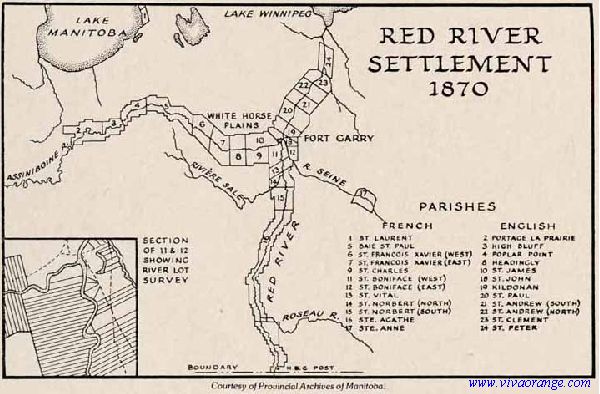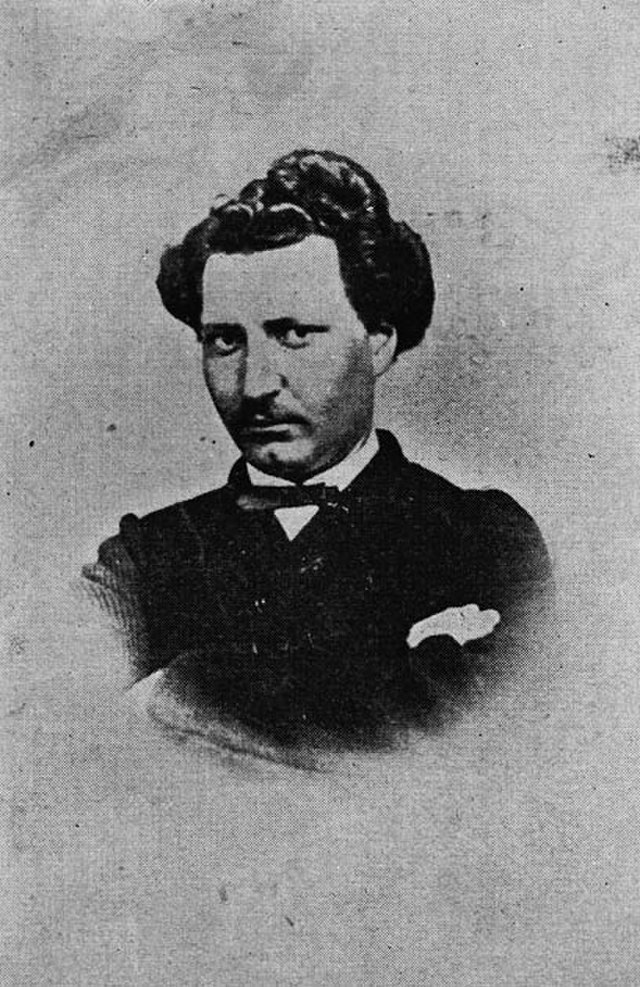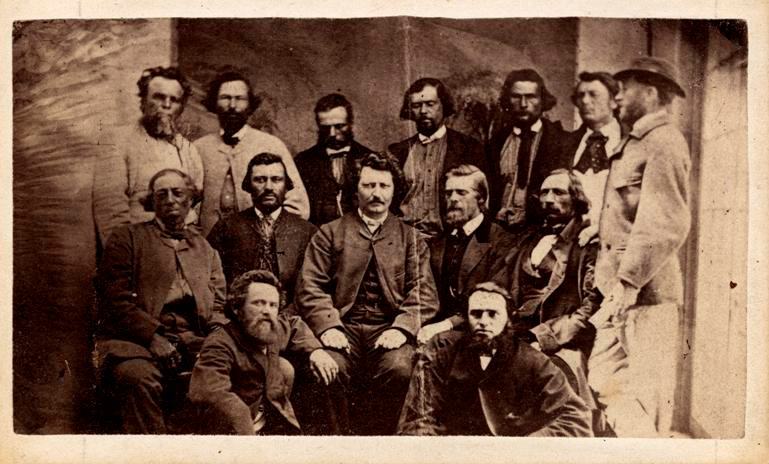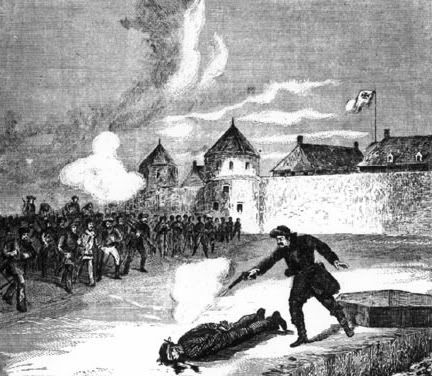
Part Two: The Red River revolution
While the rebellions of 1837-38 went down in defeat, the situation forced the British government to make concessions and reform from above. A process began which eventually led to the establishment of “responsible government” and Confederation in 1867. At first there were just four provinces, Nova Scotia, New Brunswick, Ontario and Quebec. Ultimately this was a move to avoid a situation like that of the American Revolution and limit any “excesses” by the masses.
Part One | Part Two | Part Three | Part Four
In 1868, negotiations began for the sale of the vast North-Western Territory to the new Canadian Confederation. Neither Canada nor Britain considered asking the population of the North-Western Territory, which was majority First Nations and Métis, what they thought about all of this. The Canadian bourgeoisie wanted the land and they hoped to solve this question with the stroke of a pen.
In the words of Métis Marxist Howard Adams: “This new ruling class of British financiers and Canadian industrialists had consolidated its position in Eastern Canada and was now extending its empire westward across the prairies. They wanted not only the land and the resources of the Northwest, but also a capitalist order that would consolidate and further their economic enterprises.”
The Métis, who were the main labour force in the old system, were caught in the middle and as Adams explains, “The top directors simply transferred their wealth and power from feudalist to industrialist enterprises, and consequently they wanted the land for industrial and agricultural purposes, not for trapping.” Indeed, many of the capitalists who had made their fortunes in the fur trade could see which way the winds were blowing and became shareholders in the Canadian Pacific Railway.
With the development of Canadian capitalism, speculators were salivating at the business prospects in the North West. In particular they saw great profits to be made off getting their hands on the land, which would only skyrocket in value when the railway was built and the great vast territory was populated with settlers from the east. The only problem for them was that other people, mostly Métis and First Nations, inhabited the land.
Red River was the biggest city west of Ontario at the time with a population of around 12,000, 85 per cent of which were Métis. This is where the main dramas of the coming clash would play themselves out.
Canada First
Politically, the unveiled interests of the rising Canadian capitalist class was reflected in the “Canada First” movement, which was officially founded in 1868. This eventually became the Canadian Party. This was a Canadian nationalist outfit which promoted British Protestantism and the assimilation of the French Catholics. It was heavily connected to the Orange Order, which had lodges all over Ontario at the time, and Prime Minister John A. Macdonald was a member. Ontario Premier Edward Blake and the Conservative minister of public works at the time, William McDougall, were both members of the Canada First movement.
John Christian Schultz, a shady businessman and speculator who had moved to the area in 1861, was the main Canada First supporter in Red River. Schultz bought the Nor’Wester (the only paper in the region) and turned it into an anti-Hudson’s Bay Company (HBC), pro-Canadian paper. Schultz attempted to manipulate the existing anti-HBC sentiments of the Métis and use that for his own narrow interests. In particular, Schultz used the Nor’Wester to push for the annexation of Rupert’s Land to Canada so that speculators could purchase plots of land.
In June 1869, Canada revealed its plans for governance in the North-West. The proposal was not all that surprising. Canada would have its own colony in the North-West with a lieutenant-governor and council appointed from Ottawa. The lieutenant-governor was to be a “Paternal despot, as in other small Crown Colonies, his Council being one of advice and they, however, being governed by instructions from HeadQuarters.” Within the draft plan to bring the North-West into Canada, there was absolutely no protection for the Métis or First Nations land rights. After having fought and won many battles against the HBC, this represented a huge step backwards for the people of Red River.

On Sept. 28, 1869, McDougall, a known Canada First movement member, was appointed as lieutenant-governor of the North-West Territories. His appointment was to come into effect on Dec. 1, 1869 when the land was officially transferred to Canada.
Feeling the wind in their sails, the Canadian Party was jubilant and claimed that they would “take up arms and drive out the half-breeds.” They also said that they “would all be driven back from the river & their land given to others.” There was obviously no way that the Métis were going to sit back and let this happen. And this was not simply the rumblings of a small political group. John A. Macdonald himself said that his plan was to “keep those wild people quiet. In another year the present residents will be altogether swamped by the influx of strangers who will go in with the idea of becoming industrious and peaceable settlers.”
The Red River revolution begins
The Métis revolution found leadership in the young Louis Riel who arrived in Red River in July 1868 from Montreal. The name Riel was already well known, which helped Louis connect with the Métis youth who were looking for ideas to fight back against the coming catastrophe.
Not willing to wait until the official transfer, in July 1869 Canadian surveyors began arriving, staking claims on Métis land. Riel led patrols to stop and eject the surveyors. When word got out that Riel was mounting a resistance, Métis from all over the North-West flocked to Red River to join the movement. Métis tripmen from as far as northwest Saskatchewan abandoned their brigades to come to Red River to join Riel.
Mass meetings became a regular occurrence, reviving the best democratic traditions of the Métis. What is rarely covered in official history, if at all, is precisely this movement of the masses which is the fundamental characteristic of the Métis resistance against the Canadian government. As Trotsky commented: “The most indubitable feature of a revolution is the direct interference of the masses in historical events.” In this sense, the Métis resistance, which was a heightened period of political involvement of the masses, was most definitely a revolution.
With the official transfer approaching and the new governor arriving, events evolved quickly. On Oct. 19, the Métis elected the Comite national des Métis (National Committee) with Louis Riel as secretary and John Bruce as president. The next day they learned that McDougall was on his way with a large quantity of rifles and ammunition. In response, the National Committee sanctioned the creation of a giant barrier across Pembina Trail called “La Barrière.” By this time over 500 armed Métis were at St. Norbert camp and pledged to defend the new government.
The new governor arrived at Pembina on Oct. 30 and then took residence in an HBC fort just north of the border. The Métis sent the 29-year-old Ambroise Lépine with a group of Métis to confront him. Lépine told McDougall to move South of the border. McDougall, who was shocked by this, demanded to know who had sent Ambroise. To this, Ambroise replied, “The government.” To this, McDougall asked “What government? And Lépine answered “The government we made.”
McDougall produced his papers with signatures and seals proving that he was the new appointed governor, but Lépine was unfazed by this and instructed him to leave. At this point, MacDougall realized that he was isolated and outnumbered, so he left to the American side of the border. Pierre Falcon satirized this event with a song called “The Ballad of the Trials of an Unfortunate King.”

Around the same time, rumors swirled around Red River that the Canadian Party was planning on seizing Fort Garry along with the 300 guns and 16 cannons the fort had. As a preemptive strike, on Nov. 2, the Council of the Métis Senate authorized a detachment of 120 men to seize the fort. With this bold move, the Métis had defeated the forces of reaction.
On Nov. 6, Riel drafted a proclamation to the English-speaking inhabitants of Rupert’s Land in which he announced “the invaders of our rights being now expelled.” [sic] The proclamation also invited them to send 12 representatives to a meeting held in the courthouse at Fort Garry on the 16th of November. This meeting elected a council which would govern Red River until the formation of the provisional government in December 1869.
The whip of counter-revolution
While the movement scored some early victories, the nascent Canadian capitalist state and the Canadian Party reactionaries were not going to give up that easily. Lieutenant-Colonel John Stoughton Dennis stayed with McDougall across the border in Pembina throughout November 1869 and even attempted to raise a force among the Scottish and Irish settlers, who refused, stating that they sympathized with their Métis neighbours. On Nov. 29 Dennis returned to Red River with the authorization from McDougall to raise an army to put down the “resisters.”
Dennis established a headquarters at Lower Fort Garry and called for “all loyal men” to join him. The plan was to capture Riel and place Schultz and his Canadian Party supporters in charge of the settlement. To say that this backfired is an understatement.
Originally, Riel did not want to take up arms or pursue any radical measures, but the events had a logic of their own. The whip of counter-revolution raised its head and propelled Riel and the Métis leadership down the revolutionary road. The revolutionary government took decisive measures against the forces of counter-revolution. The revolutionaries took control of the newspapers and began to search homes for Canadian Party supporters and arms. They even arrested a few prominent Métis fur traders like William Hallet for assisting Dennis. Schultz, who was holed up with a group of his followers in a warehouse, surrendered to Riel and 45 men, including Schultz, were taken prisoner.
The new revolutionary government published a “Declaration of the People of Rupert’s Land and the North West.” which was distributed all over the community and stated:
- When people have no government, they are free to adopt one form of government, in preference to another, to give or to refuse allegiance to what is proposed.
- The Hudson’s Bay Company having abandoned the people, without their consent, to a “foreign power,” the people are free to establish a provisional government and “hold it to be the only and lawful authority now in existence in Rupert’s Land and the Northwest, which claims the obedience and respect of the people.”
- The provisional government would “enter into such negotiations with the Canadian Government as may be favourable for the good government and prosperity of this people.”
When this declaration was published, any support for the Canadian Party and Dennis’s counter-revolutionary force rapidly dissipated and Dennis was forced to flee on Dec. 11.
The land was supposed to be transferred to Canada on Dec. 1, 1869 but Macdonald postponed payment to the Hudson’s Bay Company because of the disturbances in Red River.
On Dec. 10, a provisional government was formed which proclaimed the end of Hudson’s Bay Company control over the Red River region.
Revolution and counter-revolution

While the initial upsurge of the masses guaranteed the early successes of the revolution, the war was not in any way over. The strength of the revolutionary movement and the broad support it had generally shocked the Canadian government, who were forced to delay their plans and change tactics. In this, they chose the age-old tactic used by the ruling class for millennia: divide and rule.
While most books written about these events tend to emphasize the divisions between the French Catholics and English Protestants, the fact is that this was largely something artificially fomented by the Canadian Party and Macdonald while the movement itself specifically fought for unity.
The provisional government formed in December 1869 aimed to cut across linguistic and religious divisions. One merely has to look at the names of the members of the provisional government to see that there were both English and French Métis, as well as two non-Métis individuals, Pierre Thibert and an Irish Fenian, William O’Donoghue. Interestingly enough, the first list of rights did not even mention the Métis at all as it was seeking to fight against the divisions fomented by the Canadian Party. Mass democratic assemblies were commonplace with the largest of such assemblies being an open-air 1,000-person assembly in -20 degree weather.
The masses were engaged in a process of democratic participation which mirrored the process of mass upheaval in Upper and Lower Canada in 1837-38. Faced with this, the forces of reaction were doing everything in their power to divide the masses and therefore weaken the revolution. It is in the middle of this period that we find the famous trial and execution of Canadian Party member Thomas Scott.
While reactionary accounts make a lot of hullabaloo about this event, the fact is that it is massively overexaggerated for purposes of political propaganda in order to demonize Riel and the revolution. Any honest study teaches us that Scott was a despicable, violent, racist individual. He was part of a counter-revolutionary force of 60 people raised from Portage la Prairie to try to capture and kill Riel. In the process of attempting to assassinate Riel, Scott ended up dragging a Métis man, Norbert Parisien, by his neck over the ice on horseback. Parisien would later die from his wounds.
Once captured, Scott spit racist insults at Riel and said that he would kill him and burn Métis homes if he was ever let go. According to La Nouvelle Nation: “Mr. Scott was very violent and abusive in his language and actions, annoying and insulting to the guards, and even threatening the President. He (Scott) vowed openly that if ever he got out, he would shoot the president.”
Scott posed a problem for the revolution and had to be dealt with. He was one of the only remaining leaders of the Canadian Party in the region and was attempting to rile up the other prisoners. Riel actually argued against his execution, but bent to the pressure and put Scott on trial before a war council of six. This revolutionary tribunal decided by majority that Scott would be put to death by firing squad. This sentence was carried out on March 4, 1870.
The hue and cry raised over the execution of Thomas Scott is hypocritical in the extreme. These same people do not speak a word about the man Scott killed or about the genocide visited upon indigenous peoples, the oppression of the francophones or the reign of terror waged against the Métis.
Part One | Part Two | Part Three | Part Four

